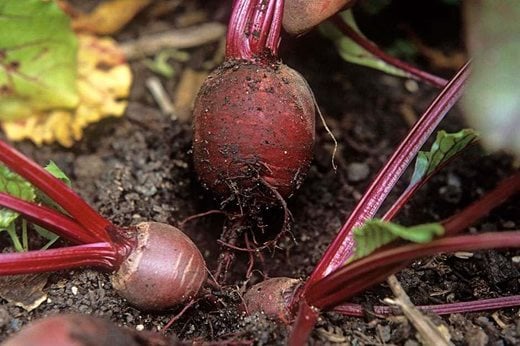Sow carrots and beetroot in containers in spring for a quick harvest of tender, tasty baby roots – simply pull, trim and rinse them, and cook them whole
 What you need
What you need
- Containers - pots, troughs, windowboxes and larger containers are all suitable – ideally ones more than 20cm (8in) deep. Sowing each crop in a separate 25cm (10in) diameter pot or a 30 x 17cm (12 x 7in) wooden box would give a worthwhile harvest. In large containers, you could sow equivalent patches of each crop, or sow roots and onions in a row around the edge and plant taller crops in the middle.
- Compost - add extra nutrients to multi-purpose compost – either mix garden compost into the bottom half of the container or add slow-release fertiliser
- Seeds: carrots – quick-maturing ‘early’ selections, such as ‘Amsterdam Forcing’ (a traditional cultivar), ‘Mignon’, ‘Ideal’.
beetroot – globe cultivars bred for ‘baby beets’ such as ‘Pronto’, ‘Pablo’.
spring onions – any cultivars such as ‘White Lisbon’, ‘Apache’ (red stemmed).
- Watering can with fine ‘rose’ (spray)
Sowing
- Fill containers to within 2-3cm (about 1in) of the rim with moist compost and firm the surface lightly.
- Scatter seeds thinly – if they are too thick, you will have to pull some seedlings out when they emerge. Aim for seedlings roughly 4-5cm (134in) apart each way for beetroot, 3cm (1in) for carrots and 2cm (34in) for spring onions. Cover with a 1.5cm (12in) layer of compost.
- Alternatively sow in rows. Make a 1.5cm (12in) ldeep groove or ‘drill’ by placing a cane along on the surface and gently pushing it into the compost. Sow seeds thinly into this and cover them with compost. Space rows 15cm (6in) apart.
- Finely spray the surface with water.
Growing
Put the containers in a sunny spot, and keep the surface of the compost moist. When the seedlings are large enough to handle, pull out unwanted ones to give the rest enough space (they won’t swell out if they are too crowded)*. As the plants grow, they will need more water – daily if the weather is dry. Don’t let the compost dry out.
* Did you find several beetroot seedlings emerging in one place? This is because the ‘seeds’ are actually several seeds clustered together in a corky case. Add the thinned-out beetroot leaves to your salads.
Harvest
Start harvesting as soon as the crops reach edible size - golfball-sized beetroot, and finger-thick carrots*, pencil-thin (or thinner) spring onions. Pull intermediate plants first, so the ones left can grow larger.
* Did you find rusty-coloured tunnels in your carrots? These are caused by the maggots of the carrot fly. If you make another sowing, cover the container with horticultural fleece to keep the egg-laying flies out, or put it up on a table: carrot flies are poor fliers and will not usually get up that high.
Added extras
Dwarf French beans will grow in bucket-sized pots or large boxes; climbing French beans and runner beans need very large containers at least 45cm (18in) deep. Cover the seedlings with fleece if frost threatens.
Get the kids involved
It's never too soon to get kids active and helping on the vegetable plot or in the garden.
Jobs to do now
Find out what to do this month on your edible plot.

